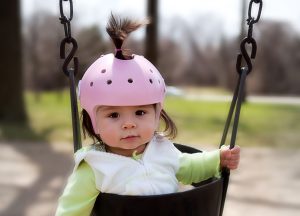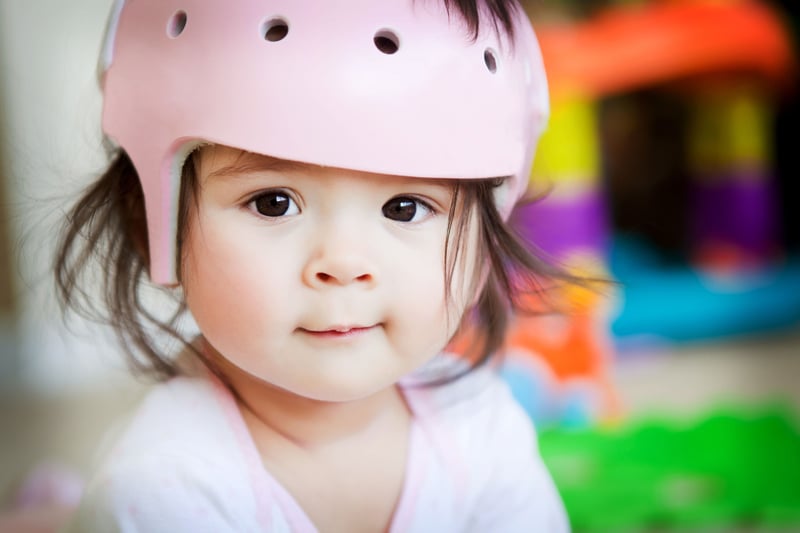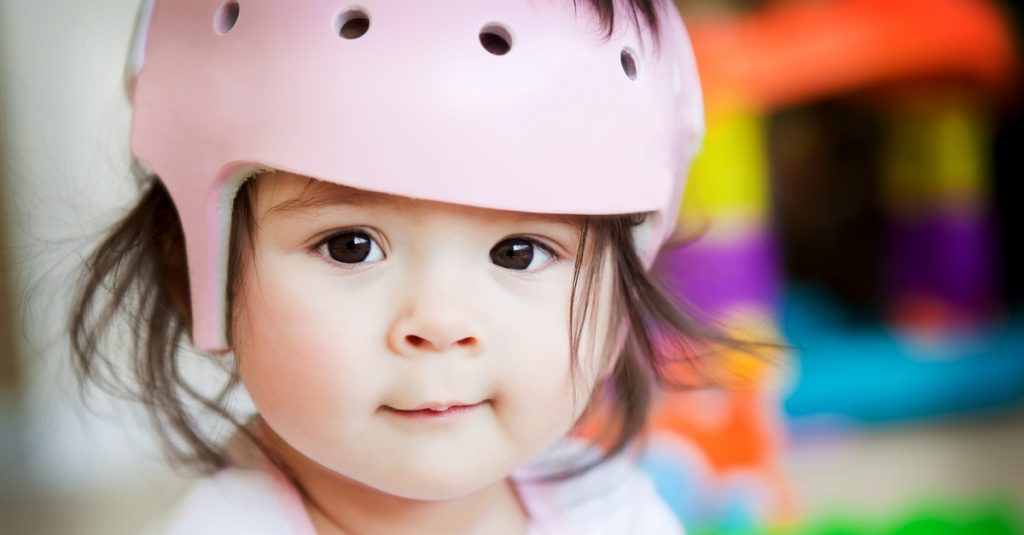A condition called cranial asymmetry - when your baby’s head is irregularly shaped - is more common today than it has ever been. We can trace this phenomenon back to 1992, when pediatric experts recommended that parents lay their infants on their backs to sleep, in an effort to avoid SIDS.
It worked - the rate of SIDS dropped by 40% in large part due to this shift - but the move also caused higher rates of cranial asymmetry.
Fortunately, the three types of cranial asymmetry - brachycephaly, plagiocephaly, and scaphocephaly - can be corrected with parenting techniques and cranial remodeling.
Here’s what you need to know about cranial remodeling to see if it’s a good fit for your infant.
Discussing Cranial Asymmetry
There are three different types of cranial asymmetry that can happen to your infant, as discussed above.
Brachycephaly is also called flat head syndrome, because a part of the baby’s skull is flat. This usually means the back of the baby’s head is flat, due to a practice of sleeping on his or her back for extended periods of time. It also results in a wider and taller head than normal.
Plagiocephaly can include flat surfaces, but it also includes distortion so that the baby’s head looks like a parallelogram if you’re looking at the top of the baby’s head. One ear may be more forward than the other, and one eye may be smaller than the other.
Scaphocephaly is caused by premature fusion of two or parts of the skull and can result in a long, narrow head.
Surgery may be required to treat some of these conditions - particularly scaphocephaly - but fortunately, cranial remodeling with cranial orthoses can correct them.
How Cranial Remodeling Works
Cranial remodeling works to reshape your baby’s head because a baby’s skull is very pliable compared to an adult skull. That’s why it gets deformed in the first place. The good news is that if it can be deformed, it can be reformed as well.
What we do is scan your baby’s head with a digital laser scanner - don’t worry, it’s perfectly safe and harmless - and upload the measurements into our 3D modeling system. From there, we design and create a foam-based cranial orthotic helmet that your baby will wear.
Your baby has to wear this all day, every day, except for when he or she is being bathed and when the helmet is being cleaned. Ideally, your infant will wear this sometime between three months and 12 months of age, when we see the most cranial growth. It may take a few months of treatment - up to six months in most cases - but the end result can be very favorable if you seek intervention early.
The helmet will reshape the baby’s skull as it grows into the shape we want it to be. You’ll still need to develop good habits - such as giving baby plenty of tummy time - but the helmet will take care of the remodeling process.
The end result should be a baby with a normally-shaped head, which makes all of us happy.
If you’re considering cranial remodeling for your baby, contact us. We’ll walk you through the process and discuss with you how cranial remodeling can be a huge benefit to your baby and your family.
 Craniosynostosis is a condition that occurs when one or more of the cranial sutures in the skull fuses too early, affecting approximately one in 2,000 infants.
Craniosynostosis is a condition that occurs when one or more of the cranial sutures in the skull fuses too early, affecting approximately one in 2,000 infants.
What Are the Symptoms?
One of the first signs that parents will often notice is that their baby has a misshapen head. There are a few other things that can cause a misshapen head, such as the cone-shaped appearance a baby’s head may have right after birth from traveling through the birth canal, or a flat spot on the back of the head from a lack of tummy time.
Therefore, it’s important to visit your doctor if you suspect any abnormalities to get a proper diagnosis.
Another sign of craniosynostosis is a missing fontanelle, commonly known of as a soft spot. The soft spot is the space that is filled in when the cranial sutures fuse. If you notice that your infant is missing a soft spot or if there is a ridge where the soft spot should be, this is a sign that he or she may have craniosynostosis.
The final sign is a lack of head growth or extremely slow head growth. At your infant’s pediatrician visits, the doctor will measure their head circumference and chart the growth.
What Are the Risks?
The prognosis is good for infants who are diagnosed early. However, if left untreated craniosynostosis can cause dangerously high pressure in the brain or even developmental delays. The brain is still growing in infants and needs enough room to properly expand.
How Is Craniosynostosis Treated?
The first step in treating craniosynostosis is surgery. During surgery the fused bone is removed, opening up space for the skull to grow. The younger the child is at the time of surgery, the better. The surgeon can use smaller incisions and the growing brain can help reshape the skull as the child gets older.
After surgery, the child will need to wear a special helmet for up to a year to reshape the head. This helmet is typically worn 24 hours a day so comfort and proper fit is very important - this is where BioTech comes in!
BioTech Can Create a Custom Device for Cranial Remodeling
If your child has been diagnosed with craniosynostosis, BioTech can help create a custom helmet for your little one.
We create a 3D scan of the child’s head that records detailed measurements. This is a non-invasive, pain-free procedure that allows us to create a comfortable helmet.
The child is then fitted with a lightweight, plastic and foam orthosis to remold the head into the proper shape.
Contact BioTech today and get a free evaluation from our cranial remolding center.
 One condition that has become more common today in infants than ever before is cranial asymmetry.
One condition that has become more common today in infants than ever before is cranial asymmetry.
This condition is a cranial deformation that impacts 18 to 28 percent of infants. The rise of this condition is directly related to how we let infants sleep today – on their backs for long periods of time. This comes from a “Back to Sleep” campaign launched in 1992 from the American Academy of Pediatrics.
Cranial remodeling is a treatment that was created as a way to combat and ultimately treat cranial asymmetry. Here, we’ll explain cranial asymmetry and then discuss how cranial remodeling can help.
Cranial Asymmetry Defined
Cranial asymmetry is when an infant’s skull becomes deformed. Sometimes this happens prior to birth, or even during birth; other times it happens due to how the baby sleeps. The main cause is a restriction of growth in a fixed area.
There are a few different types of cranial asymmetry:
- Plagiocephaly: when one side of the back of the infant’s head is flat, resulting in a forehead bulge on the same side
- Brachycephaly: when the back of the head is flattened symmetrically
- Scaphocephaly: when the infant’s head is long from the front to the back and narrow from one side to the other
Cranial asymmetry can be prevented or treated early on through the use of cradling or repositioning. If a treatment plan hasn’t happened prior to three months of age, however, deformity could result, which means cranial remodeling might be needed.
Cranial Remodeling Explained
Cranial remodeling is a treatment process designed to correct the deformities caused by cranial asymmetry.
This treatment starts at three months of age and can be performed all the way up to 18 months. It involves carefully measuring your infant’s head and obtaining precise measurements that enable the creation of a special helmet that is then fitted to the infant.
The helmets themselves are made of a hard outer shell constructed from plastic and lined with foam that ensures a snug but comfortable fit for the infant.
By wearing this helmet 23-24 hours per day (removed only to clean it), the infant will start to have his or her head gently remodeled back into correct shape and alignment. Your orthotic specialist will periodically measure and evaluate the progress made by the helmet over the next few months (treatment typically lasts three to four months).
The ideal end result is a correctly aligned head free of major deformities.
If you think your infant may have cranial asymmetry and may be in need of a consultation for a cranial helmet to correct the condition, then please contact BioTech.
